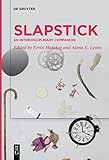Slapstick: An Interdisciplinary Companion / ed. by Alena E. Lyons, Ervin Malakaj.
Material type: TextPublisher: Berlin ; Boston : De Gruyter, [2021]Copyright date: ©2021Description: 1 online resource (IX, 414 p.)Content type:
TextPublisher: Berlin ; Boston : De Gruyter, [2021]Copyright date: ©2021Description: 1 online resource (IX, 414 p.)Content type: - 9783110570793
- 9783110570977
- 9783110571981
- 792.23 23/ger
- online - DeGruyter
- Issued also in print.
| Item type | Current library | Call number | URL | Status | Notes | Barcode | |
|---|---|---|---|---|---|---|---|
 eBook
eBook
|
Biblioteca "Angelicum" Pont. Univ. S.Tommaso d'Aquino Nuvola online | online - DeGruyter (Browse shelf(Opens below)) | Online access | Not for loan (Accesso limitato) | Accesso per gli utenti autorizzati / Access for authorized users | (dgr)9783110571981 |
Frontmatter -- Acknowledgements -- Contents -- Introduction: Interdisciplinary Approaches to Slapstick -- Part I: History of Slapstick -- Introduction -- The Descent of Slapstick -- Ideology, Performance, and Ironic Distance in Musical Slapstick -- Sinking and Falling Bodies: The Beginnings of Literary Slapstick in the Pre-Modern Era -- Part II: Instruments of Slapstick -- Introduction -- The Broken Mirror: From Commedia All’Improvviso to Slapstick Comedy -- Harold Lloyd and the Reappearing Hand: Disability, Embodiment, and Slapstick -- Wardrobe Malfunction and Slapstick Humiliation in The Lonely Island’s Popstar: -- Gazing at Slapstick with Luiza Folegatti’s Drag King Series O Deleite da Mulher Barbada -- Part III: Narrative Structures of Slapstick -- Introduction -- Telling and Showing: Slapstick in Stephan Schütze’s Comic Theory and Heinrich von Kleist’s Der zerbrochne Krug -- A Constraint-Based Approach to the Slapstick Seriality in Larry Semon Comedies, 1918–1920 -- The Anonymized Randomness of Vicco von B.: On Chaos and Order in Loriot’s Agfa Advertisements -- Part IV: Bodies of Slapstick -- Introduction -- The Tragicomic Body: On the Relation between Tragicomedies and Slapstick -- ‘Or Words to That Effect’: The Antimetaphysics of Slapstick -- Gender and Jewish Difference in Early German Slapstick -- Part V: Politics of Slapstick -- Introduction -- Slapstick Comediennes in Silent Cinema: Women’s Laughter and the Feminist Politics of Gender in Motion -- Lubitsch’s Queer Slapstick Aesthetics -- The Slapstick of Greater Mexico: The Poetics and Politics of Eugenio Derbez -- Interpersonal and Social Sensibility in Slapstick from the Perspective of Religious History -- Part VI: Sticking to the Slap: The Contact Points of Slapstick -- Closing Remarks: Creating Openings -- Each One, Who Falls – A Conversation -- Contributors -- Index
restricted access online access with authorization star
http://purl.org/coar/access_right/c_16ec
Despite its unabated popularity with audiences, slapstick has received rather little scholarly attention, mostly by scholars concentrating on the US theater and cinema traditions. Nonetheless, as a form of physical humor slapstick has a long history across various areas of cultural production. This volume approaches slapstick both as a genre of situational physical comedy and as a mode of communicating an affective situation captured in various cultural products. Contributors to the volume examine cinematic, literary, dramatic, musical, and photographic texts and performances. From medieval chivalric romance and nineteenth-century theater to contemporary photography, the contributors study treatments of slapstick across media, periods and geographic locations. The aim of a study of such wide scope is to demonstrate how slapstick emerged from a variety of complex interactions among different traditions and by extension, to illustrate that slapstick can be highly productive for interdisciplinary research.
Issued also in print.
Mode of access: Internet via World Wide Web.
In English.
Description based on online resource; title from PDF title page (publisher's Web site, viewed 25. Jun 2024)


